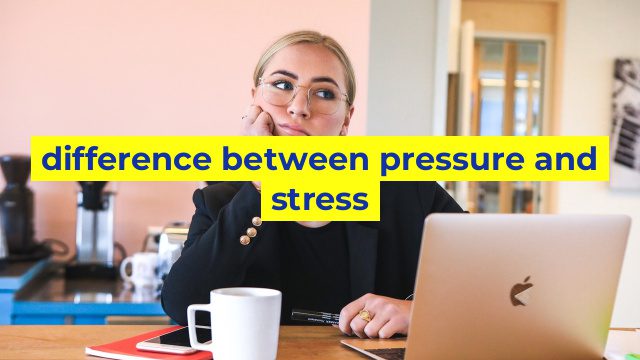Distinguishing Between Pressure and Stress: What You Need to Know
When someone talks about feeling tense or overwhelmed, it’s common to use the terms ‘pressure’ and ‘stress’ interchangeably. However, they are not the same thing – and understanding the key differences between the two can be important for managing our mental and physical health.
What is Pressure?
Pressure is the external demand that we feel to meet certain expectations or standards. It can come from a variety of sources, such as work, school, family, or societal norms. For instance, a deadline at work might create pressure to complete a project on time, or an upcoming exam could create pressure to study for long hours.
In many cases, pressure can be a positive motivator that drives us to achieve our goals. It can inspire us to work harder, focus more, and hone our skills. However, when pressure becomes excessive or unrelenting, it can have negative effects on our mental and physical well-being.
What is Stress?
Stress is the physical and emotional response that our bodies have to pressure. It’s the feeling of being overwhelmed, anxious, or exhausted that often accompanies heavy demands or difficult situations. Stress can have a variety of symptoms, such as headaches, muscle tension, fatigue, irritability, and difficulty sleeping.
Unlike pressure, stress is an internal experience that is generated by our bodies in response to external factors. It’s not always caused by negative events – positive changes and transitions can also create stress. For example, starting a new job or getting married can be exciting, but they can also be stressful due to the changes and adjustments involved.
The Importance of Managing Pressure and Stress
Both pressure and stress can have significant impacts on our health and well-being. While pressure can be positive and motivating at times, it can also lead to burnout, anxiety, and physical illness if it becomes chronic or excessive. Likewise, stress can lead to a variety of physical and mental health problems if it’s not addressed and managed effectively.
By understanding the difference between pressure and stress, we can take steps to manage both and optimize our overall wellness. This might involve strategies such as practicing self-care, setting realistic expectations, practicing mindfulness, seeking support from others, and learning to say ‘no’ when needed.
In conclusion, while pressure and stress may be commonly used interchangeably, it’s important to recognize that they are not the same thing. By taking a proactive and integrative approach to managing both, we can lead healthier, more balanced lives.
Table difference between pressure and stress
| Pressure | Stress |
|---|---|
| Pressure is the force exerted by a fluid or gas on a surface. | Stress is the force exerted on an object due to an external load or force. |
| It is measured in units of force per unit area, such as pounds per square inch (psi) or pascals (Pa). | It is measured in units of force per unit area, similar to pressure, but also takes into account the cross-sectional area of the object being stressed. Units of stress include pounds per square inch (psi), pascals (Pa), or newtons per square meter (N/m^2). |
| Pressure is a scalar quantity, meaning it has only magnitude and no direction. | Stress is a vector quantity, meaning it has both magnitude and direction. |
| Pressure can be present in fluids and gases, but not in solids. | Stress can be present in both solids and fluids. |
| Examples of pressure include atmospheric pressure, blood pressure, and water pressure. | Examples of stress include tensile stress, compressive stress, and shear stress. |
